Prabhu Bhaktina Pagthare Asht Prakari Pujano Ras
Added to library: September 2, 2025

Summary
Here is a comprehensive summary of the Jain text "Prabhu Bhaktina Pagthare Asht Prakari Pujano Ras" (The Path of Devotion to the Lord: The Verses of Eight Types of Worship), authored by Kavi Udayratna, with compilation and translation by Sadhvi Shri Dadhshakti Shri M.S. and others:
Overall Theme:
The book "Prabhu Bhaktina Pagthare Asht Prakari Pujano Ras" is a detailed exploration of the eight types of worship (Ashtaprakari Puja) as prescribed in Jainism. It aims to elucidate the profound significance and benefits of performing these rituals with both material substance (dravya) and devotion (bhava). The text emphasizes that sincere worship leads to liberation from the cycle of birth and death and ultimately to the attainment of eternal bliss.
Core Concepts:
- The Value of Human Birth: The text begins by highlighting the rarity and preciousness of human birth, especially within the Jain tradition, emphasizing that its ultimate purpose is the soul's liberation from karmic bondage and the attainment of its pure, luminous form.
- Bhakti Yoga (Devotion) as a Means to Liberation: The book presents Bhakti Yoga, or devotion, as a powerful and accessible path to achieving liberation. It describes devotion as an "infallible weapon" capable of drawing liberation closer, akin to a magnet drawing iron.
- Dravya Bhakti (Material Worship) and Bhava Bhakti (Devotional Worship): The text differentiates between material worship (performing rituals with substances like sandalwood, flowers, etc.) and devotional worship (adoring the Tirthankaras through praise, hymns, and following their teachings). It asserts that both are essential, with material worship acting as a catalyst to draw forth inner devotion.
- The Ashtaprakari Puja: The central theme revolves around the eight types of worship, which are typically:
- Chandan Puja (Sandalwood Worship): Symbolizing peace and coolness.
- Dhup Puja (Incense Worship): Representing spiritual ascent.
- Akshat Puja (Unbroken Rice Worship): Symbolizing incorruptibility and birthlessness.
- Pushpa Puja (Flower Worship): Representing a life filled with fragrance and virtues.
- Deepak Puja (Lamp Worship): Symbolizing the destruction of ignorance and the illumination of knowledge.
- Naivedya Puja (Food Offering Worship): Symbolizing the destruction of desires and the attainment of the state of being without sustenance (anahari).
- Phala Puja (Fruit Worship): Representing the ultimate fruit of salvation (Moksha).
- Jala Puja (Water Worship): Symbolizing the purification of the soul and the washing away of impurities.
- Illustrative Stories (Drishtanta): The book is rich with stories and parables from Jain scriptures and traditions. These narratives illustrate the power and efficacy of each type of worship. For instance, stories of kings, queens, princes, and virtuous individuals who achieved spiritual merit or even liberation through performing specific types of worship (like Chandan or Dhup puja) are used to inspire readers. These stories often highlight that even a single act of sincere devotion can yield immense benefits.
- The Role of the Gurus: The text is dedicated to revered Jain Acharyas and Sadhvis, particularly those who inspired and guided the compilation and translation of this work, such as Acharya Shri Vijai Kalapurna Surishwarji M.S., Acharya Shri Vijai Kripaprabh Surishwarji M.S., Sadhvi Shri Divyakirnashriji M.S., Sadhvi Shri Divyadarshnashriji M.S., and Sadhvi Shri Drudhshaktishriji M.S. Their blessings and guidance are acknowledged throughout the book.
- Spiritual Guidance and Inspiration: The book aims to uplift the spiritual journey of the readers, encouraging them to cultivate devotion and engage in the Ashtaprakari Puja. It seeks to make the teachings accessible, especially to younger generations, by including colorful illustrations alongside the devotional verses and their explanations.
Structure and Content:
The book is structured as a "Ras" (a devotional ballad or poem meant for recitation and singing), composed by Kavi Udayratna. It is presented in a verse-by-verse format with:
- Doha (Couplets): Introducing verses and concepts.
- Dhal (Stanzas/Chapters): Each devoted to a specific aspect of the worship or a narrative illustration.
- Bhavarth (Meaning/Explanation): Providing a clear explanation of the verses.
- Drishtanta (Illustrations/Stories): Narratives that exemplify the spiritual benefits of the worship.
- Illustrations: The book is noted for including colorful and thematic illustrations to enhance the devotional experience and understanding.
Key Narratives Mentioned:
The text explicitly mentions stories like:
- Jaysoor Raja and Shubhmati Rani: Illustrating the benefits of Chandan Puja and achieving liberation.
- Dhupasar Kumar: Demonstrating the power of Dhup Puja to attain eternal happiness.
- Harishchandra Raja: His penance and spiritual journey.
- Vijaya Chandra: A king who embraced spiritual devotion.
- Madnavali: Her story related to the benefits of worship.
Purpose of the Book:
The primary purpose of this work is to:
- Deepen the reader's understanding and appreciation of the Ashtaprakari Puja.
- Inspire sincere devotion (bhakti) towards the Tirthankaras.
- Provide spiritual guidance and motivate readers to practice these rituals with faith and sincerity.
- Serve as an educational resource for Jain followers, fostering a connection with their spiritual heritage.
In essence, "Prabhu Bhaktina Pagthare Asht Prakari Pujano Ras" is a devotional guide that uses poetic verses and compelling narratives to illuminate the path of sincere worship, promising spiritual elevation and ultimate liberation for the devoted soul.